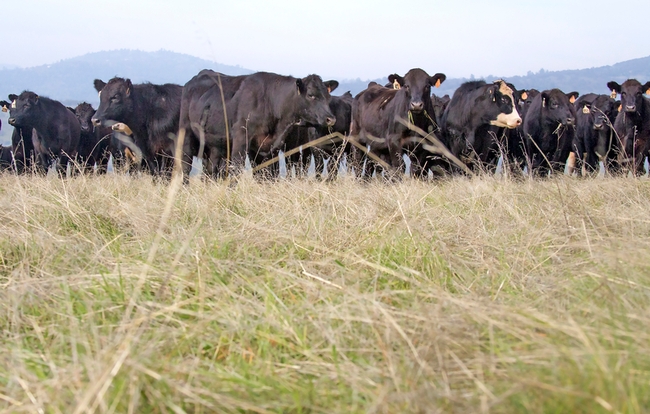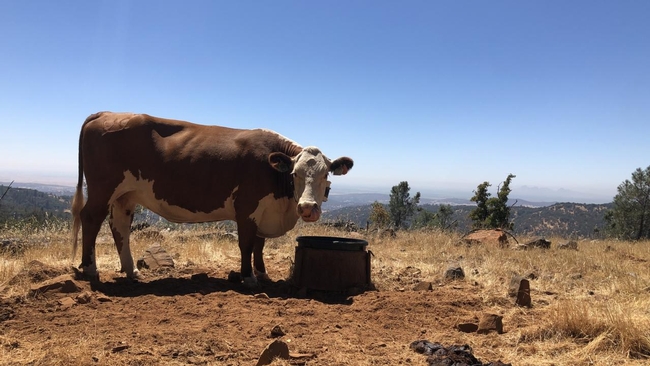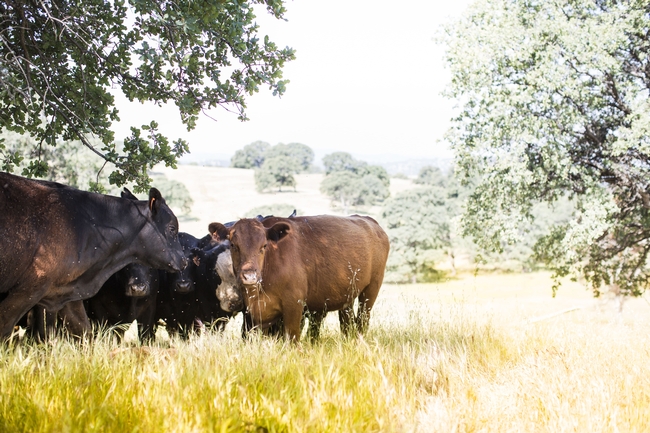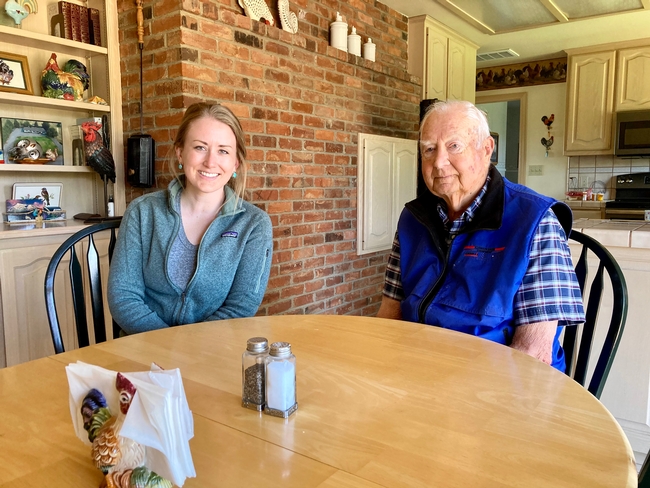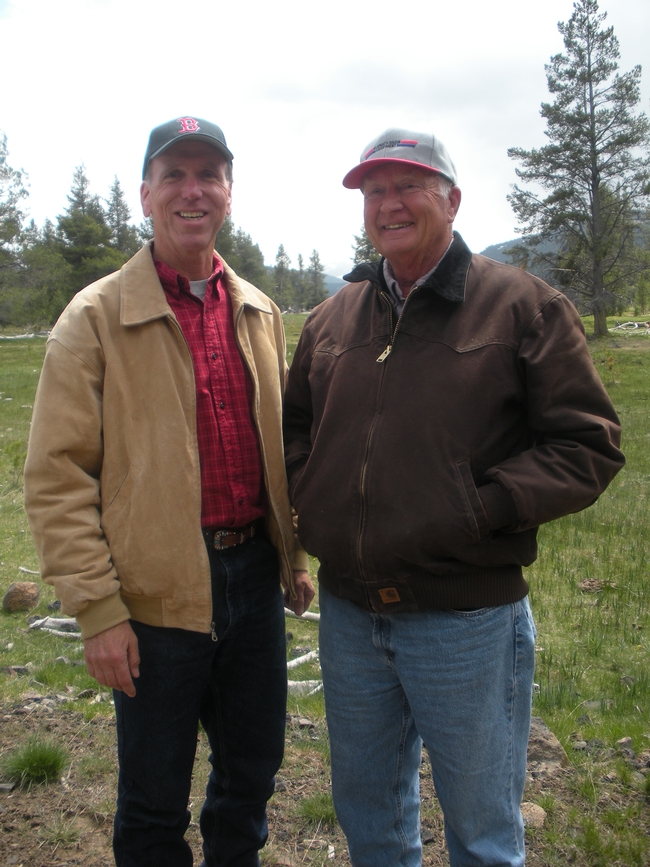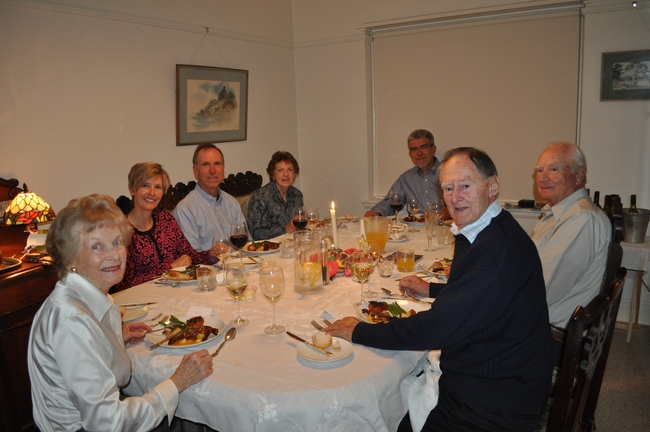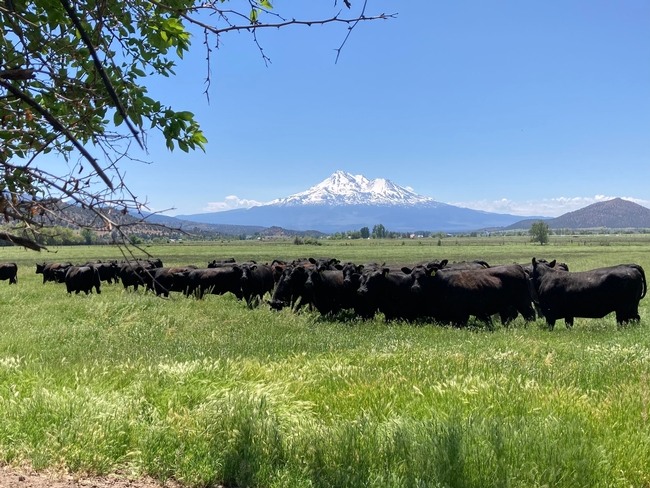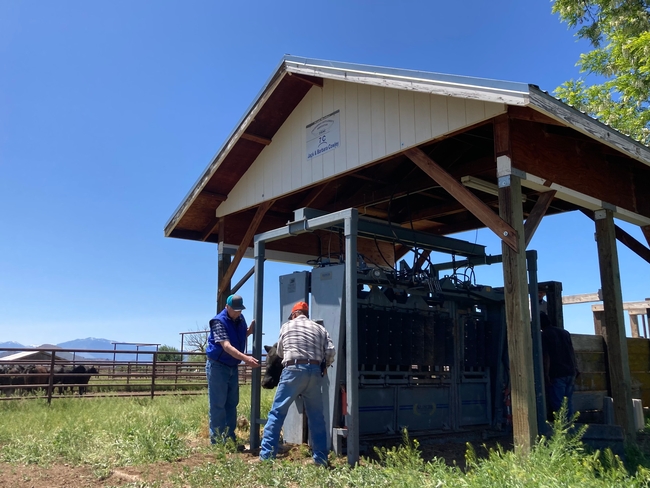
Posts Tagged: cattle
Feeding grazing cattle seaweed cuts methane emissions by almost 40%
Findings offer solution for more climate-friendly cattle farming
Seaweed is once again showing promise for making cattle farming more sustainable. A new study by researchers at the University of California, Davis, found that feeding grazing beef cattle a seaweed supplement in pellet form reduced their methane emissions by almost 40% without affecting their health or weight. The study was published Dec. 2 in Proceedings of the National Academy of Sciences.
This is the first study to test seaweed on grazing beef cattle in the world. It follows previous studies that showed seaweed cut methane emissions 82% in feedlot cattle and over 50% in dairy cows.
How much methane do cattle produce?

“Beef cattle spend only about three months in feedlots and spend most of their lives grazing on pasture and producing methane,” said senior author Ermias Kebreab, professor in the Department of Animal Science. “We need to make this seaweed additive or any feed additive more accessible to grazing cattle to make cattle farming more sustainable while meeting the global demand for meat.”
Difficulty in reducing methane emissions from cattle
Kebreab said that daily feeding of pasture-based cattle is more difficult than feedlot or dairy cows because they often graze far from ranches for long periods. However, during the winter or when grass is scarce, ranchers often supplement their diet.
For this study, researchers divided 24 beef steers (a mix of Angus and Wagyu breeds) into two groups: one received the seaweed supplement, and the other did not. Researchers conducted the 10-week experiment at a ranch in Dillon, Montana. Since these were grazing cattle, they ate the supplement voluntarily, which still resulted in a nearly 40% cut in emissions.
Most research studies to reduce methane emissions using feed additives have taken place in controlled environments with daily supplements. But Kebreab noted in the study that fewer than half of those methods are effective for grazing cattle.
“This method paves the way to make a seaweed supplement easily available to grazing animals,” said Kebreab. “Ranchers could even introduce the seaweed through a lick block for their cattle.”
Kebreab said pastoral farming, which includes large grazing systems, supports millions of people around the world, often in areas vulnerable to climate change. This study suggests a way to make cattle grazing better for the environment, while playing a role in fighting climate change.
A related article in the same PNAS issue highlights the need to improve the efficiency of livestock production in low- and middle-income countries using better genetics, feeding and health practices. UC Davis Professor and Cooperative Extension Specialist Alison Van Eenennaam, the article's author, said it is the most promising approach to meet the global demand for meat while limiting greenhouse gas emissions.
Other authors of the seaweed study include UC Davis postdoctoral researchers Paulo de Méo Filho and John-Fredy Ramirez-Agudelo.
The research was supported by Matador Ranch in Dillon, Montana.
This article was first published on the UC Davis news site.
Virtual fencing ‘game-changer’ for ranchers grazing cattle
Tech can save ranchers time and benefit animals and land, becoming more viable
After the Caldor Fire destroyed seven miles of fencing on their cattle ranch in 2021, Leisel Finley and her family needed to replace the fence.
Finley, a sixth-generation rancher at Mount Echo Ranch in Amador County, said reconstruction costs were bid at $300,000 and would take at least a year to build, leaving the family without summer pasture and a herd of hungry cows to feed. Additionally, the U.S. Forest Service mandates that grazing be withheld for two years in postfire landscapes. This put the family in a difficult position.
While watching a recording of a California Cattlemen's Association meeting, Finley learned about a pilot program for virtual fencing. Desperate to find an alternative solution, she registered to try the livestock containment technology, which uses GPS enabled collars to monitor each animal's location in near real time.
Livestock producers can draw a perimeter on a map of their pasture using a laptop or smartphone application and send those instructions to the collar. The collar then uses audio and tactile cues to contain the animal in the area.
Eager to discover the short- and long-term benefits of virtual fencing, Finley turned to Scott Oneto, farm advisor, and Brian Allen, assistant specialist, from the University of California Cooperative Extension office in the Central Sierra. Since partnering with Oneto and Allen, Finley said she has come to understand and uncover more of the technology's potential.
The team has consistently observed the technology's value in integrating with and enhancing traditional livestock production systems across California. Though still in its early stages of development, the location tracking and containment system appears to provide time- and cost-savings that make it a game-changer for ranchers.
Ability to monitor location of animals in real time
Virtual fencing really stands out in its ability to monitor each animal's location in real time. During roundups, ranchers can use their smartphones to see their own location relative to their herd. The system can also send alerts if an animal crosses the virtual boundary or if a collar remains stationary for an extended period, potentially indicating that the animal is sick or that the collar has fallen off.
Rounding up cattle on large, forested grazing allotments can be challenging, as the process generally requires a group of people and many return trips to find every animal. Prior to virtual fencing, Finley and her father could gather about 85% to 90% of the herd in a week. Since using virtual fencing, Finley said one of their most recent roundups lasted three days, and they located every single cow.
Something that every livestock producer dreads is the notorious call from a neighbor or California Highway Patrol alerting them that one of their cows is out in the middle of the road. It always seems to happen at midnight or while they are out with friends or family. This scenario changes with virtual fencing.
Containment based on animal behavior
The containment system that virtual fencing is built on is based on animal behavior. When the animal crosses an invisible boundary, the collar emits an audio warning, prompting most animals to instinctively turn back into the desired area. If the animal doesn't respond, the collar delivers a mild electric pulse as a secondary deterrent.
Field trials by Oneto and Allen demonstrated the system's success. Recently, the team trained a herd of 37 cattle of mixed ages that had no previous exposure to virtual fencing. During the initial six-day training period, the cattle responded to the audio warning alone about 75% of the time when they approached a virtual fence boundary, with the remaining 25% of cases requiring an electric pulse.
After about three weeks, the herd was responding to audio cues alone about 95% of the time. The field trials also showed that the collars contain the livestock within the desired areas 90% to 99% of the time when the entire herd wears virtual fence collars and their basic needs for safety, connection to the rest of the herd, water, forage, shade, etc. are met.
Opportunities for improvement
While the technology is effective in its current capacity, there are notable areas where it can improve. One limitation to the system is the current reliance on cellular networks to operate. If an animal wanders into an area outside of coverage, the collar will continue to operate based on the last instructions but won't receive updates or report locations. This is especially a concern in many areas of California with poor cell reception, including the steep forested rangelands where many livestock producers have summer grazing allotments.
Another limitation is that some companies require a solar-powered base station with radio and cellular antennas to be placed on the pasture. These facilitate the transfer of animal locations and updates to the virtual fences. A base station going offline would create the same conditions as a drop in cell signal until the base station is repaired. Some companies are currently developing collars that bypass the need for these base stations.
The other major concern for ranchers is the cost for a virtual fencing system. The average rancher can expect to pay an estimated $20,000 to $30,000 in upfront costs. The cost to set up a base station alone is $5,000 to $10,000. However, this cost is highly dependent on several factors, including the manufacturer, the number of livestock to be collared, if the livestock are large or small ruminants, and the number of GPS base stations to cover the range.
According to Allen and Finley, the high cost of virtual fencing can be offset by the unique animal and land management benefits it can provide. “While physical perimeter fencing remains essential, VF is rapidly emerging as an innovative tool to control livestock with ease, precision, and flexibility in ways that were not previously feasible with traditional fencing,” Allen said.
Finley described the technology as a “game-changer” for her family.
Virtual fencing helps control invasive grasses, installing fuel breaks
While virtual fencing is designed to contain livestock without physical fencing, it is not intended to outright replace secure perimeter fencing. Instead, it operates best as a highly dynamic and adaptable cross-fence, allowing for more intentional grazing on the landscape to meet livestock production and natural resource conservation objectives within a secure physical perimeter.
With grant funding from the USDA Natural Resources Conservation Service, the UCCE team continues to work with Finley and other livestock producers to test these applications on California's diverse rangelands.
Within the Sierra Nevada and Coast Ranges foothills, these trials include using virtual fencing on cattle for targeted grazing of invasive grasses to support the recovery of native forage and installing fuel breaks within the wildland-urban interface to remove vegetation where the edge of a pasture meets urban housing.
Using virtual fencing, 25 cattle were successfully concentrated on a field of Medusahead (Elymus caput-medusae), an invasive annual grass. The herd respected the virtual fencing boundary 99% of the time despite nearby preferable forage. Grazing reduced medusahead seed heads from 2,072 per square meter in the ungrazed control area to just 68 per square meter in the grazed section.
In a different trial, 37 cattle with virtual fencing collars were contained within 120-feet-wide fuel breaks along the boundary of an annual rangeland and residential area. Cattle stayed within the boundaries 99% of the time, leading to an 81% reduction in fine fuel biomass and lowering wildfire risk in the wildland-urban interface.
Within rangelands on conifer forests, these UCCE trials concentrate cattle on brush to reduce the flammable plants and vegetation that competes with desirable timber species. It also can prevent livestock from entering sites that are sensitive to livestock presence.
Upcoming grazing trials will focus on how virtual fencing works with goats and sheep. In addition to Oneto and Allen, UCCE's contribution to virtual fencing research is in large part due to Leslie Roche, UCCE specialist and associate professor at UC Davis, Dan Macon and Jeff Stackhouse, UCCE livestock and natural resources advisors, Kristina Horback, associate professor at UC Davis and Lone Star Ranch in Humboldt County.
To learn more about the trials led by the UCCE team,visit https://cecentralsierra.ucanr.edu/Virtual_Fencing/
Understanding cattle grazing personalities may foster sustainable rangelands
Matching herds to landscape can support animal growth and ecological needs
Not all cattle are the same when it comes to grazing. Some like to wander while others prefer to stay close to water and rest areas.
Recognizing those personality differences could help ranchers select herds that best meet grazing needs on rangelands, leading to better animal health and environmental conditions, according to a new paper from the University of California, Davis, published in the journal Applied Animal Behaviour Science.
“Cattle can actually be beneficial for the rangelands,” said lead author Maggie Creamer, who recently earned her Ph.D. in animal behavior at UC Davis. “Vegetation in rangelands actually need these kinds of disturbances like grazing.”
Ranchers can add elements to the rangeland such as water, mineral supplements and fencing to influence where cattle graze, but little research has been done on how those efforts affect individual cows. Considering personalities could save money.
“If you're spending all this money to add a management tool in order to change the distribution of your animals, that's a huge cost to ranchers,” said Creamer. “Thinking about other tools, or selecting certain animals with these grazing traits, might be a better way to optimize the distribution on rangeland rather than spending a bunch of money for something that may ultimately not pan out for all your animals.”
Effects of grazing
Livestock graze on an estimated 56 million acres in California, and healthy rangelands host native vegetation and animals, foster nutrient cycling and support carbon sequestration.
Uneven grazing can degrade water quality, soil health and habitats. Optimizing grazing — including the even spread of cow pies — can improve the ecosystem while also reducing fuel loads for wildfires.
To better understand individual grazing patterns, researchers went to the UC Sierra Foothill Research and Extension Center in Browns Valley and tracked 50 pregnant Angus and Hereford beef cows fitted with GPS collars.
The research
The cattle, which were tracked from June to August over two years, had access to 625 acres of grasslands and treed areas ranging in elevation from 600 to 2,028 feet. In the second year, a new watering site was added at a higher elevation.
Across the two years, the cows showed consistent and distinct grazing patterns even when water sources changed. Age and stage of pregnancy did not affect patterns, though cattle tended to clump near water and rest sites on hotter days.
The cows that ventured into higher elevations and farther from watering sites had more variability in their grazing patterns than those that stayed at lower elevations near water. That suggests it may be harder for non-wanderers to adjust to some landscapes.
“Thinking about the topography of your rangeland and your herd of cows can benefit both the animals and the sustainability of the land,” said Creamer, who next month begins work as a postdoctoral scholar in North Carolina.
Gauging personalities
Keying in on personality type may sound difficult, but the researchers also found some clues as to how to pinpoint the wanderers and homebodies. Unlike cattle at feedlots, the breeding cow population, especially on rangelands in California and other western states, live largely “wild” lives and are rarely handled, save for vaccinations and weaning.
Research due to be published later this year found that paying attention to individual cow reactions during those events can help determine personalities. The cows that appeared more passive during those handling interactions tended to be nomadic.
“We found that you can maybe predict those hill climbers if you kind of look at how they act when the veterinarian or rancher handle them,” said senior author Kristina Horback, an associate professor in the Department of Animal Science at UC Davis.
Informing practices
For ranchers, the findings could be invaluable, said Dan Macon, a livestock and natural resources Cooperative Extension advisor in Placer and Nevada counties for UC Agriculture and Natural Resources.
“Any time we can improve our understanding of cattle behavior, particularly at the individual level, it can improve how we handle livestock and manage the landscape,” he said.
Macon said that during the recent drought, it was hard to get cattle into higher country, but if ranchers could have selected the nomads, it may have saved money in terms of ranch labor and other efforts.
“If you ask a rancher who has been attentive to their cattle over many years, they know the personalities,” Macon said.
For Creamer and Horback, the research opens new doors into understanding herd behavior and dynamics, one that could be a cheaper alternative to high-tech solutions.
“Animal science tends to look overlook the mind of the animal when searching for solutions to challenges,” Horback said. “It's always been a direct line to genetics for immunity or nutrition, but nothing about the mind of the animal. And that's such a loss. There's so much we can learn from behavior in the end.”
The Russell L. Rustici Rangeland and Cattle Research Endowment supported the research.
This article was first published on the UC Davis News site.
Fighting fire with feeding
Are cattle a secret weapon for taking on California wildfires?
California's cattle ranchers contribute a significant amount to the region's culture, economy and food supply, but do they also inadvertently help to temper the wildfires that have been plaguing the state? And if so, is it a better alternative – environmentally speaking – to letting grasslands burn?
A new study published in the journal Sustainability delves into the topic, weighing the advantages – and disadvantages – grazing cattle bring to the table. Researchers, including scientists from University of California, Davis and UC Agriculture and Natural Resources, set out to calculate the greenhouse gas emissions of cows consuming vegetation that would otherwise burn in wildfires. Then they estimated the GHG emissions that would result should that forage be untouched and therefore, consumed by fire, eventually comparing the two.
Feeling the burn
Given the severity of California's recent wildfires and the belief they will continue and even escalate in the near future, it's a discussion worth having, said Frank Mitloehner, an expert in animal agriculture and air quality from UC Davis, director of the CLEAR Center and one of the researchers who contributed to the peer-reviewed article.
“Each year from 2010 to 2020, California lost on average 89,000 acres of grassland to wildfires,” said Mitloehner, who is also a Cooperative Extension specialist. “In addition to the obvious disruption and devastation they caused, the fires spewed greenhouse gases and harmful particulate matter such as black carbon into the air and into our atmosphere. Those alone threaten climate health and human well-being.”
A fast and furious gas
Cattle are adept at eliminating herbaceous fuel as they graze. However, at the same time, their specialized digestive system produces methane that is expelled most often in the form of enteric emissions … more commonly known as belches. By way of background, methane is a potent greenhouse gas that warms the atmosphere at 25 times the rate of carbon dioxide over 100 years. But it's only in the atmosphere for 10 to 12 years after it's emitted. Following that, it's broken down into carbon dioxide and water vapor.
For that reason, Mitloehner refers to methane as a “fast and furious” gas. Furious because it warms with a vengeance and fast because it does so for only a short time, especially when compared to carbon dioxide. Furthermore, because of the biogenic carbon cycle, whereby plants extract carbon dioxide from the atmosphere for photosynthesis, the warming of methane and its byproducts can end entirely when it's hydrolyzed and used by plants.
How researchers calculated emissions
In order to determine if grazing, methane-emitting cattle are better for the atmosphere than burning grasslands, Mitloehner and the other researchers employed a method known as “Monte Carlo simulation,” a mathematical technique used by scientists to predict outcomes of an uncertain event.
Looking exclusively at methane emissions, they found it's better to have cows eat vegetation than to have wildfires burn it. Granted, it's only marginally better, but when one considers other advantages of animal agriculture and conversely, other disadvantages of widespread, uncontrolled fire, the conversation suddenly shifts.
“Even if cattle provided no other benefit to us, which certainly is not true, we can now make the case that they are helpful to us in yet another way,” Mitloehner said.
Friends or foes?
It goes without saying that one would be hard pressed to find much good to say about wildfires, but that doesn't hold true for animal agriculture. The industry provides jobs and supports the economy in other ways as well. Plus, it is a major source of protein-rich food that is in increasing demand as the world's population continues on a trajectory toward 10 billion people by the year 2050.
Where global warming is concerned, the industry is in the unique position of being able to reach net-zero warming, also known as climate neutrality, if it continues to aggressively chip away at its methane emissions, which Mitloehner asserts is of critical importance to the planet. “Few other sectors can reduce its warming to net zero and still be of service to society, but agriculture can because of the way methane behaves in the atmosphere,” he says.
To be clear, grazing cows are no match for wildfires. Yet, in addition to everything else the sector does for us, slowing the burn and keeping relatively more methane from entering the atmosphere are not nothing.
In addition to Mitloehner, authors of the study are Cooperative Extension advisors Sheila Barry, Devii Rao and Theresa Becchetti; Rowan Peterson, Ermias Kebreab and Minju Jung of UC Davis; and Felix Ratcliff and Kaveh Motamed of LD Ford.
This article was first published on the website of the CLEAR (Clarity and Leadership for Environmental Awareness and Research) Center at UC Davis.
Cattleman’s four decades of UCCE collaborations advance ranching practices
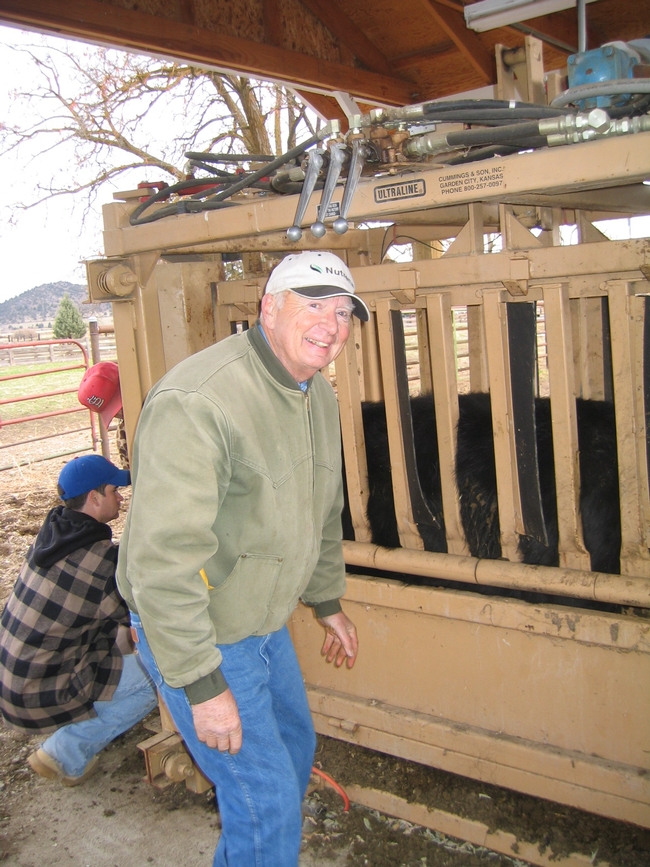 Siskiyou County rancher Jack Cowley has collaborated with UC Cooperative Extension scientists on research projects ranging from weed control to cow genetics for 40 years. The cooperation of farmers and ranchers is critical for producing practical research, scientists say. Photo by Alison Van Eenennaam
Siskiyou County rancher Jack Cowley has collaborated with UC Cooperative Extension scientists on research projects ranging from weed control to cow genetics for 40 years. The cooperation of farmers and ranchers is critical for producing practical research, scientists say. Photo by Alison Van Eenennaam

Eye doctor-turned-rancher brings science background to his second career
Siskiyou County rancher Jack Cowley, 91, joyfully recalled the special Christmas gift that delighted his seven children in the 1960s. Cowley, then a practicing eye doctor in Sacramento, and his late wife Barbara surprised the children with a white quarterhorse, which they named Silver.
“That's how it all started!” exclaimed Cowley, reflecting on the gift horse that would eventually lead to a 40-year collaboration with University of California Agriculture and Natural Resources.
Silver was the impetus for his family's involvement with the 4-H Youth Development Program, a part of UC ANR. Cowley also would later transition to a second career in cattle ranching, and collaborate with UC Cooperative Extension on research projects ranging from weed control to cow genetics.
“Jack has been an extremely committed supporter of UCCE,” said Grace Woodmansee, who became the UCCE livestock and natural resources advisor for Siskiyou County in 2021. “He has worked with UCCE extensively and contributed a lot of time and resources to supporting local and statewide projects.”
Lately Cowley and his son David have been working with Woodmansee and Gabriele Maier, UC Cooperative Extension specialist in the UC Davis School of Veterinary Medicine, on a cow deworming study.
Not only has Cowley allowed UCCE scientists to study his cattle over the years, he has been willing to personally share information with scientists and cattle producers across the country and internationally.
“It is important to foster exchange and linkages, said Dan Drake, UCCE farm advisor emeritus in Siskiyou County, who collaborated with Cowley for 30 years. “He went to so many meetings, especially with the early and uncharted areas of cattle genetics. Jack was on a first-name basis with the leaders from other states and the relationships were important in both directions. Frankly, I think many of those folks were jealous of the great cooperator we had in California.”
Breeding for better beef
After retiring from his Sacramento ophthalmology practice in the 1990s, Cowley settled in Montague in Siskiyou County, 246 miles north of the closest UC campus. There he met then-UC Cooperative Extension farm advisor Steve Orloff and Drake. Orloff advised him on alfalfa production and pasture management while Drake offered counsel on animal health records, organizing breeding, animal nutrition and water issues.
Drake explained to ranchers that by selectively breeding cows based on genetics, they could improve the production and quality of beef so that it's healthier for humans.
“My medical background helped me understand animal genetics,” Cowley said. “We can modify the genetics to improve the quality of the beef to make it more heart-healthy.”
In 2009, Drake introduced Cowley to UC Cooperative Extension specialist Alison Van Eenennaam, who studies animal genetics at UC Davis.
“I was looking to set up a research trial where we would follow cattle from the ranch all the way through to the Harris Ranch processing plant in the Central Valley,” said Van Eenennaam, who worked with Cowley on a three-year project.
Using DNA samples from Cowley's cattle, they evaluated the data they received from processor Harris Ranch of the beef characteristics – such as tenderness -- to compare the different breeds.
“I really thought I knew what I was doing and my cattle graded terribly,” Cowley said.
Since beginning the genetics project, his beef quality steadily improved.
“We're now up to where all of our animals are graded anywhere from 20% to 40% Prime and the rest Choice,” said Cowley, adding that he stopped striving for higher grades because the buyer said there was a limited market for the more expensive meat.
Cowley takes pride in knowing breeding practices developed from the research he and UC Cooperative Extension conducted have been adopted globally by dairy producers and beef producers.
“The type of research we were doing there has eventually evolved to now we have these genomic tests that you can use that genetically predict the performance of animals,” Van Eenennaam said. “Nowadays people just take an ear tag and send it in and get their genetic prediction.”
Van Eenennaam credits Cowley for allowing research on his large herd. “Jack was very patient with things that take a long time. When researchers come onto your ranch, that could slow you down.”
She added, “Genetic improvement, of course, is a huge component of sustainability because the more efficient cattle are, the less feed they consume and the less time they take to finish, which ultimately lessens their environmental footprint.”
Growing up in Utah
Looking back, Cowley marvels that he has been fortunate to do what he wanted to do in life.
“I was interested in ranching when I was probably seven or eight years of age,” said Cowley, who delivered the local Deseret Newspaper on horseback as a boy. “I grew up in Utah, you know, a little town in Utah called Holladay. It was not a ranching community.”
After serving four years in the Air Force during the Korean War, he returned to Utah to find the cute girl he met in first grade had graduated from college and was still single. He married Barbara in 1956. When he was accepted at George Washington University medical school, they drove with their three-week-old baby from Utah to Washington, D.C. He got a job in the Senate office building as an elevator operator working from 5 to 11 p.m., which enabled him to study, meet influential people and finish medical school without debt.
“I actually got to meet Khrushchev,” he said, recalling his encounter with the Soviet leader..
After finishing his ophthalmology residency at UCLA, Cowley established his practice in Sacramento and later taught a few classes at UC Davis Medical School.
Becoming a cattleman
One Saturday afternoon, after Silver the horse joined the family, Cowley and his oldest daughter, Kathryn, were driving in Placerville and saw a ranch for sale. He bought the 90 acres. For two summers, Barbara and the children lived at the ranch and Cowley joined them on weekends.
“Of course, I had to have a few cows to play with,” he said with a chuckle. “Basically, I thought I could make some money off of 50 cows.”
As his herd grew, he moved it to Corning, 50 miles south of Redding, and finally to the site in Montague that could accommodate several hundred head of cattle. “That's when I really became interested in animal genetics,” Cowley said. “That was back when we had slide rules to do our calculations. It was pretty crude, but it was a start.”
In 1990, Cowley was honored as the California Beef Cattle Improvement Association's Seedstock Producer of the year and, in 2007, was named Siskiyou County's Cattleman of the Year. He has served as president of the Siskiyou County Cattlemen's Association, on the Cattlemen's Beef Board, as well as on committees for the National Cattlemen's Beef Association.
“Jack spent countless hours traveling to the Midwest and other beef research institutions to share knowledge, learn more and plan for needed information,” said Drake, emeritus UCCE livestock advisor. This made for better Extension work, better research and recognition of UC Cooperative Extension work nationwide.”
In 2011, when Van Eenennaam and Drake presented their research at an international genomics conference, he joined them in Australia to learn from other researchers. They also visited Australian producers to learn their practices.
“We really rely on cooperators like Jack to enable our research to have translation to farmers and ranchers,” Van Eenennaam said.
In recent years, Cowley has handed the ranch reins over to his children David, Brian, Brent and Kathryn, who live in Siskiyou County.
David, who retired from a nearly 40-year career as a software engineer, plans to continue working with UC Cooperative Extension advisors and specialists.
“Any time you have questions, you can call and they're more than happy to help you,” he said.







